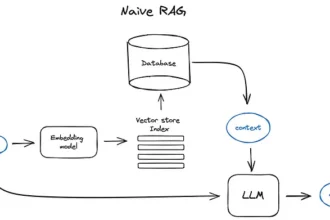Are you ready to tackle the complexities of generative AI in your next job interview? As this technology rapidly transforms industries, understanding its nuances becomes essential. This guide is your map through the labyrinth of generative AI, offering over 50 meticulously crafted questions and answers that cater to everyone from enthusiastic newcomers to seasoned experts. With a blend of theory and practical insights, we’ll prepare you not just to answer questions, but to engage meaningfully in conversations that could define your career. Buckle up; it’s going to be an enlightening journey!
- This post offers a comprehensive guide to prepare for Generative AI job interviews, balancing theory with practical skills.
- A detailed list of over Generative AI interview questions and answers is included to help candidates prepare effectively.
- By reviewing the questions and answers, candidates can enhance their knowledge and performance during interviews.
Table of Contents
ToggleGenerative AI Interview Questions and Answers
Generative AI is not just a buzzword; it’s a captivating branch of artificial intelligence that dives into the creation of new content—think text, images, music, and even code. As this field evolves at breakneck speed, gearing up for interviews in generative AI requires more than just surface-level knowledge. You need to blend theoretical insights with hands-on skills to truly stand out.
This guide serves as your go-to resource, packed with a wealth of questions and detailed answers designed to bolster your confidence and showcase your expertise during interviews. Whether you’re fresh out of college or a seasoned professional, understanding the nuances of generative AI can set you apart from the competition.
From foundational concepts to advanced techniques, we’ve compiled an extensive list of interview questions that reflect current industry trends and expectations. For instance, you might encounter inquiries about the differences between various generative models like GANs (Generative Adversarial Networks) and VAEs (Variational Autoencoders), or how prompt engineering can significantly influence the output quality in language models.
Moreover, practical scenarios are often presented in interviews.
You could be asked to demonstrate how you would approach a project involving content generation or how to fine-tune a model for specific tasks. This is where your ability to articulate both your thought process and technical skills will shine.
So gear up! With this comprehensive guide at your fingertips, you’ll be well-equipped to tackle any generative AI interview question that comes your way. Remember, it’s not just about knowing the answers; it’s about conveying your passion for the field and your readiness to contribute meaningfully to potential employers.
Overview: Understanding Generative AI
Imagine you’re teaching a computer to draw. You show it thousands of pictures of cats, and it learns the patterns—the shape of the ears, the fluffy tail, the whisker arrangement. The computer now knows how to draw a cat, but it hasn’t just copied the pictures; it’s learned the underlying structure. This “understanding” of what makes a cat is stored in something called “latent space.”
Latent space is essentially a hidden world where the computer represents all the possible variations of a cat.
It’s like a blueprint that holds the recipe for generating a cat, with sliders for adjusting its size, fur color, and even its expression. By manipulating these sliders, you can create new, never-before-seen variations of cats.
That’s the power of latent space: it allows generative models to create new, original content by combining and manipulating learned patterns.
Key Concepts in Generative AI
Key Concepts in Generative AI
Generative AI is a fascinating field that intertwines various advanced technologies and concepts. Here’s a deeper look at some of the pivotal elements:
- Deep Learning: This is a branch of machine learning that mimics the way our brains operate through neural networks. These networks consist of layers of interconnected nodes, which process data in complex ways. The depth and architecture of these networks allow them to learn intricate patterns, making them particularly effective for tasks like image recognition and natural language processing.
- Large Language Models (LLMs): These models are trained on extensive datasets, enabling them to generate human-like text. They leverage vast amounts of information to understand context, semantics, and nuances in language. For instance, models like GPT-3 have shown remarkable capabilities in generating coherent essays, poetry, and even code snippets, showcasing their versatility across different domains.
- Generative Adversarial Networks (GANs): GANs consist of two neural networks—the generator and the discriminator—that engage in a game-like scenario. The generator creates data samples while the discriminator evaluates them against real data. This adversarial process pushes both networks to improve continuously, resulting in highly realistic outputs such as images or audio. For example, GANs have been used to create lifelike portraits that are indistinguishable from real photographs.
- Adversarial Attacks: These are strategies designed to trick generative models into producing incorrect or misleading outputs. By subtly altering input data, attackers can exploit vulnerabilities within the model. This highlights the need for robust defenses and continuous monitoring to ensure reliability and trustworthiness in generative AI applications.
The interplay between these concepts not only enhances our understanding of generative AI but also underscores its potential applications across various industries—from creative arts to software development—making it essential knowledge for professionals in tech fields today.
Common Generative AI Interview Questions and Answers
Generative AI is a fascinating field with immense potential, and navigating interviews for these roles requires a deep understanding of the underlying concepts and practical applications. I’ve been fortunate to be involved in this space, working on projects that push the boundaries of what’s possible with AI. Here are some common interview questions, and how I’ve approached them in my own experience:
1. What differentiates generative models from discriminative models?
This is a fundamental question that delves into the core of how these models operate. Generative models, like their name suggests, focus on creating new data based on learned patterns. They aim to understand the underlying data distribution and generate samples that resemble the real data. Think of it like learning how to draw a cat from a bunch of cat pictures—the model learns the underlying “blueprint” and can then create new cat drawings.
Discriminative models, on the other hand, are more about classification.
They learn to distinguish between different classes in data by identifying the decision boundary that separates them. They don’t try to generate new data but rather focus on assigning data points to their respective categories. Think of it like building a machine that can tell the difference between a cat and a dog.
2. Can you explain your experience with unsupervised or semi-supervised learning using generative models?
Unsupervised learning with generative models is a powerful technique that allows us to glean insights from unlabeled data.
I’ve personally worked on projects using Variational Autoencoders (VAEs) to cluster data without relying on pre-defined labels. VAEs are particularly adept at finding hidden relationships and patterns within unlabeled data, enabling them to generate samples that reflect the underlying structure.
For instance, in a project involving customer behavior analysis, we used VAEs to identify distinct customer segments based on their purchase history and browsing patterns, even without explicit labels for these segments. This allowed us to understand the nuances of customer behavior and tailor marketing strategies accordingly.
3. Describe how you assess the quality of generated samples from a generative model?
Evaluating the quality of generated samples is crucial to ensure the model’s effectiveness.
This involves a combination of qualitative and quantitative approaches. Qualitative analysis involves subjective assessment of the generated content, considering factors like realism, diversity, and coherence.
For example, if we’re generating images, we might look for visual artifacts, consistency of features, and overall aesthetic appeal.
Quantitative measures offer a more objective way to assess quality.
Metrics like Inception Score (IS) and Fréchet Inception Distance (FID) are commonly used to compare the generated samples to real data, evaluating factors like diversity and photorealism. A high IS score indicates diversity and quality, while a low FID score suggests that the generated samples are similar to real data.
4. How do you stay updated with the latest advancements in generative AI?
The field of generative AI is evolving rapidly, so continuous learning is crucial. I make it a habit to stay informed by actively engaging with research papers, online forums, and industry newsletters. Platforms like ArXiv are invaluable for accessing cutting-edge research, and attending conferences like NeurIPS allows me to connect with leading experts and gain firsthand insights into the latest trends.
5. Can you elaborate on adversarial attacks on generative models and possible defenses?
Adversarial attacks are a serious concern in generative AI, as they exploit vulnerabilities in models to generate incorrect or misleading outputs. These attacks can involve subtly altering input data to trick the model into producing unintended results. Imagine feeding a cat image with a tiny, imperceptible change—this alteration might be enough to make the model misclassify it as a dog.
Defending against these attacks requires robust strategies. One common approach is adversarial training, where the model is trained on both normal and adversarially perturbed inputs, making it more resilient to such attacks.
This is just a glimpse into the world of generative AI interviews. It’s a dynamic field where curiosity, a thirst for knowledge, and a willingness to explore are essential. Remember, it’s not just about knowing the answers; it’s about demonstrating your passion for the field and your ability to contribute meaningfully to the advancements in this space.
Practical Preparation Tips
The Generative AI job market is heating up, and you want to be ready. To ace your interview, you need to think like an engineer and approach it strategically. Here’s my take on practical preparation tips:
- Master the Fundamentals: Start with a strong foundation in machine learning. It’s like learning the alphabet before you can write a novel. Understand the key concepts, algorithms, and different types of machine learning. I’ve found that a good grasp of supervised, unsupervised, and reinforcement learning is essential.
- Code Your Way to Success: Python is the language of choice in AI, so make sure you’re fluent in it. I recommend diving deep into libraries like TensorFlow, PyTorch, and Keras. These are the tools you’ll need to build your own generative models and showcase your skills.
- Data Science is Your Weapon: Generative AI relies heavily on data. Get familiar with data exploration, cleaning, and preprocessing. You’ll need to be able to understand and manipulate data to train effective models.
- Generative Frameworks are Key: Dive into generative AI frameworks like GANs (Generative Adversarial Networks) and VAEs (Variational Autoencoders). Understand their architectures, strengths, and weaknesses. Be ready to discuss how you’d use them in real-world applications.
- Build Your Portfolio: Theory is great, but hands-on experience is essential. Work on projects that involve generative tasks. For example, try building a text generator, an image generator, or a music composer. Having concrete examples of your work will impress interviewers and demonstrate your skills.
Remember, it’s not just about knowing the answers. It’s about showing your passion and your ability to think critically. Practice your communication skills, and be ready to articulate your ideas clearly and confidently.
Advanced Generative AI Interview Questions
For candidates seeking senior roles, here are additional advanced questions:
- What types of generative models have you worked with, and in what contexts?
- Can you discuss your approach to mitigating the risks of bias in generated outputs?
- Explain the concept of Recurrent Neural Networks (RNNs) and their application in generative tasks.
Conclusion
As the generative AI landscape continues to evolve, candidates must maintain their curiosity and adapt to new developments. Reflect on your personal experiences, enhance your skills through practical projects, and prepare thoroughly for the varied interview questions that will likely arise. Embrace this journey confidently, and showcase your unique insights and capabilities in generative AI!
FAQ & Questions
What are the core principles of Generative AI that candidates should understand?
Generative AI revolves around several core principles, including the understanding of models like Generative Adversarial Networks (GANs) and Large Language Models (LLMs). Candidates should grasp how these models function, the theory behind them, and their real-world applications. For instance, GANs generate new data by competing two models: a generator that creates content and a discriminator that evaluates it. Understanding concepts such as training methods, overfitting, and ethical implications of generated content is crucial for demonstrating expertise in interviews.
How can I effectively prepare for a Generative AI interview?
Preparation for a Generative AI interview hinges on a multi-faceted approach. Start by mastering foundational topics like deep learning and data processing techniques. Engage in hands-on projects that showcase your skills, and familiarize yourself with common interview questions that probe your theoretical knowledge and practical experiences. Staying updated with the latest advancements, attending webinars or workshops, and contributing to open-source projects can give you an edge, showcasing both your knowledge and passion for Generative AI.
What are the types of generative models and their applications?
Candidates should be familiar with various generative models such as Variational Autoencoders (VAEs), GANs, and autoregressive models. Each model has unique characteristics and applications: for example, GANs are often used in image generation, while VAEs excel in generating new data from learned distributions. Discussions around how these models are applied in real-life projects, from content creation to drug discovery, can impress interviewers and showcase a well-rounded understanding of the field.
Can you explain adversarial attacks on generative models, and how can they be mitigated?
Adversarial attacks exploit vulnerabilities in generative models, where malicious inputs manipulate the model’s output, leading to unsafe results. Understanding the mechanisms behind these attacks is vital. Candidates can discuss defense strategies like adversarial training, where models are exposed to adversarial examples during training, or using robust optimization techniques to enhance model resilience. Demonstrating knowledge on this important topic reflects a candidate’s preparedness for real-world challenges in AI development.
What is the role of prompt engineering in generative AI?
Prompt engineering serves as a crucial bridge between human intent and machine understanding in generative AI. It involves crafting inputs or queries that effectively guide the model toward desired outputs. Candidates should explain how well-structured prompts can lead to coherent and contextually relevant content generation. Skills in prompt engineering not only enhance interaction with LLMs but also reflect a deep understanding of AI’s interpretative capacity and potential pitfalls.





